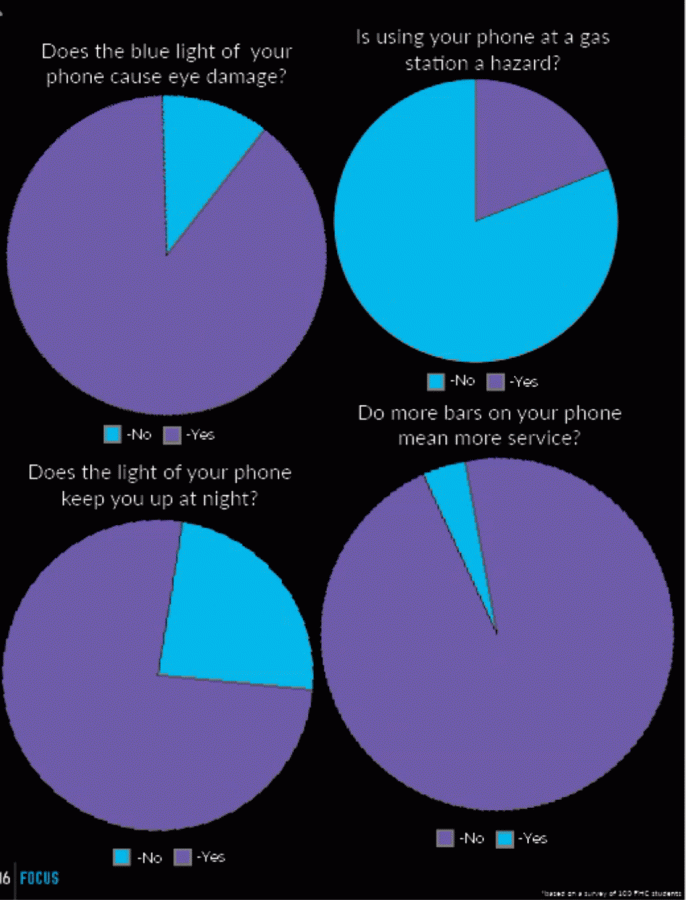Fact or Fiction
With new technologies comes new myths and rumors
November 14, 2018
“Standing too close to the microwave causes cancer,” the headline flashes across the screen on Twitter. The ‘researchers’ who wrote the report found a correlation between the two. It sounds feasible, so it starts to rapidly spread throughout different social media platforms.
The truth is, headlines are meant to grab the attention of the audience, but it doesn’t always mean it’s true or at least the whole truth. Psychology teacher Stacey Dennigmann teaches the students in her classes to always pay attention to the sources behind information because correlation doesn’t equal causation.
“Any time you use a correlational study, it’s not going to determine cause and effect. We can say ‘this tends to’ or ‘this could predict’ or ‘this might be a possibility,’ but then we always need to see the data and the results afterwards,” Mrs. Dennigmann said. “How close is that to a perfect one? So I think a lot of times when we hear studies being released, we never ask ourselves, how strong was that? What were the numbers telling me? It can be a slight positive correlation, but it could still be a weak one.”
Myths can be embedded in the beliefs of a family or community. For example, sophomore Anna West grew up believing standing too close to the TV was harmful because that’s what her family believed was the truth.
“A lot of adults would tell me [standing too close to the TV] was bad. My mom would tell me when I was at my grandparent’s house and sat too close. I thought I could see the show better but they said it was worse for you,” West said.
It sounds believable, but the experts at the American Academy of Ophthalmology disagree. In fact, it might actually be beneficial because children will be able to read the material in front of them more efficiently.
“Contrary to the popular myth, sitting too close to a TV will not damage your eyes but it may cause eyestrain. Children can focus at close distance without eye strain better than adults. Therefore children often develop the habit of holding reading materials close to their eyes or sitting right in front of the television. There is no evidence that this damages the eyes either in children or adults,” according to AAO’s website.
While there are many myths about technology and social media, there are many truths backed up by trustworthy research. It’s important to question the source and do some digging to figure out if something is true or not. Mrs. Dennigmann explains the truth behind how the light from our phones affect our brain.
“When we look at the light spectrum the colors that are on our phones, even when they’re turned off or turned over, those colors directly impacts us and our brain picks up on them. Even though we are not aware of them, our brain is stimulated by those colors and starts firing and send us messages. So it does interfere with our sleep patterns,” Mrs. Dennigmann said.
The writers for the National Sleep Foundation explain the science behind how the light affects our brain and why it interrupts our sleep cycle.
“Smartphones — like laptops, tablets, and televisions — emit something called blue light, which is a type of light that the brain interprets as daylight. The blue light actually suppresses melatonin (a hormone that affects circadian rhythm and should increase when you are preparing for bedtime). The result: Your brain feels stimulated,” according to the National sleep foundation website.
Another factor Mrs. Dennigmann considers: Is the study complete yet? Assuming something is true due to past knowledge is not the same as proving something is true. At the moment, psychologists know technology is having an effect on the brain. Is it a positive or negative impact? A little bit of both? The answer is not evident yet due to the lack of research done.
“Being exposed to technology at such an early age is causing the brain to kind of rewire itself. Those are a few new things that are coming out in the American Psychology Association and Psychology Today magazine. It’s too soon to say “Is this good?” or ‘Is this bad?” There’s not enough research that’s been done on that, but they are seeing an impact,” Mrs. Dennigmann said.
Certain studies could be influenced if the people behind the research behind the study are biased. It can ruin the credibility of the entire study because the results are just not accurate. If Instagram funded a study on whether or not social media is a healthy pastime, we all know what direction the data would be skewed. West agrees the opinions and experience of an author behind a study determines whether it is true or not.
“Some studies could be untrue, it just depends on the author and whether or not they are biased,” West said. “A lot of authors who are older are biased towards social media and technology because they didn’t grow up with it and don’t understand how much teenagers use it.”
There are benefits behind technology, and there are negatives behind technology. When it comes down to it, always question the motives and the research behind everything on the internet. Be skeptical. Find trustworthy research. There’s nothing wrong with digging deeper than what is displayed in a headline.
“It’s always a double-edged sword, there’s always good with technology because it gets results faster, it’s more convenient and it’s easier. What happens though is we feel like we don’t really need to pay attention to what’s going on,” Mrs. Dennigmann said. “We really truly don’t, in a learning situation, have to pay that close attention to encode to store it and retrieve it for later. We know we can go somewhere and the information will be there.”



